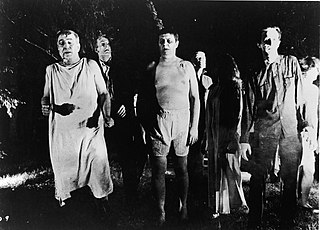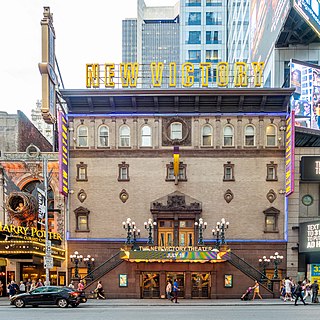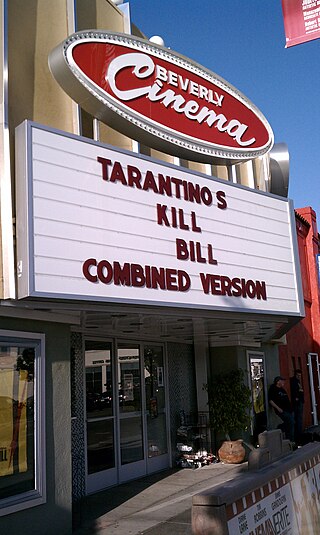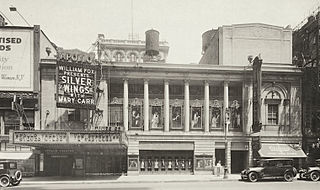
42nd Street is a major crosstown street in the New York City borough of Manhattan, spanning the entire breadth of Midtown Manhattan, from Turtle Bay at the East River, to Hell's Kitchen at the Hudson River on the West Side. The street hosts some of New York's best known landmarks, including the headquarters of the United Nations, the Chrysler Building, Grand Central Terminal, the New York Public Library Main Branch, Times Square, and the Port Authority Bus Terminal.

A movie theater, cinema, or cinema hall, also known as a movie house, picture house, picture theater or simply theater, is a business that contains auditoria for viewing films for public entertainment. Most are commercial operations catering to the general public, who attend by purchasing tickets.

A B movie, or B film, is a type of low-budget commercial motion picture. Originally, during the Golden Age of Hollywood, this term specifically referred to films meant to be shown as the lesser-known second half of a double feature, somewhat similar to B-sides in the world of recorded music. However, the production of such films as "second features" in the United States largely declined by the end of the 1950s. This shift was due to the rise of commercial television, which prompted film studio B movie production departments to transition into television film production divisions. These divisions continued to create content similar to B movies, albeit in the form of low-budget films and series.

An exploitation film is a film that tries to succeed financially by exploiting current trends, niche genres, or lurid content. Exploitation films are generally low-quality "B movies", though some set trends, attract critical attention, become historically important, and even gain a cult following.

The double feature is a motion picture industry phenomenon in which theatres would exhibit two films for the price of one, supplanting an earlier format in which the presentation of one feature film would be followed by various short subject reels.

A sexploitation film is a class of independently produced, low-budget feature film that is generally associated with the 1960s and early 1970s, and that serves largely as a vehicle for the exhibition of non-explicit sexual situations and gratuitous nudity. The genre is a subgenre of exploitation films. The term "sexploitation" has been used since the 1940s.
Sleazoid Express was the house journal of the grindhouse movie scene in New York circa 1964-1985. Founded as a one-sheet by Bill Landis, an NYU graduate, projectionist, and devotee of the crime-ridden sleaze houses, the magazine not only captured the genre affections but the whole Times Square milieu of drugs, violence and prostitution. Typical films featured in the magazine, which centered 42nd Street, included The Love Butcher, Pink Motel, Shocking Asia, Boardinghouse and Do Me Evil. Approximately 48 issues were published over a five-year period, the first issue being dated June 18, 1980, and the last issue appearing in the fall of 1985.

Grindhouse is a 2007 American film written and directed by Robert Rodriguez and Quentin Tarantino. Presented as a double feature, it combines Rodriguez's Planet Terror, a horror comedy about a group of survivors who battle zombie-like creatures, and Tarantino's Death Proof, an action thriller about a murderous stuntman who kills young women with modified vehicles. The former stars Rose McGowan, Freddy Rodriguez, Michael Biehn, Jeff Fahey, Josh Brolin, and Marley Shelton; the latter stars Kurt Russell, Rosario Dawson, Vanessa Ferlito, Jordan Ladd, Sydney Tamiia Poitier, Tracie Thoms, Mary Elizabeth Winstead, and Zoë Bell. Grindhouse pays homage to exploitation films of the 1970s, with its title deriving from the now-defunct theaters that would show such films. As part of its theatrical presentation, Grindhouse also features fictitious exploitation trailers directed by Rodriguez, Rob Zombie, Edgar Wright, Eli Roth, and Jason Eisener.

I Drink Your Blood is a 1971 American exploitation horror film written and directed by David E. Durston, produced by Jerry Gross, and starring Bhaskar Roy Chowdhury, Jadine Wong, and Lynn Lowry. The film centers on a small town that is overrun by rabies-infected members of a Satanic hippie cult after a revenge plot goes horribly wrong.

Pieces is a 1982 Spanish-American slasher film directed by Juan Piquer Simón, written and produced by Dick Randall, and starring Christopher George, Lynda Day George, Frank Braña, Edmund Purdom, Paul L. Smith, Ian Sera, and Jack Taylor.

Death Proof is a 2007 American slasher film written and directed by Quentin Tarantino. It stars Kurt Russell as a stuntman who murders young women with modified cars he purports to be "death-proof". Rosario Dawson, Vanessa Ferlito, Jordan Ladd, Rose McGowan, Sydney Tamiia Poitier, Tracie Thoms, Mary Elizabeth Winstead, and Zoë Bell co-star as the women he targets.

Planet Terror is a 2007 American action comedy horror film written and directed by Robert Rodriguez. Set in Texas, the film follows the survivors of a biochemical outbreak as they battle zombie-like creatures and a rogue military unit. It stars Rose McGowan, Freddy Rodriguez, Michael Biehn, Jeff Fahey, Josh Brolin, and Marley Shelton.

The 1960s and 1970s marked the rise of exploitation-style independent B movies; films which were mostly made without the support of Hollywood's major film studios. As censorship pressures lifted in the early 1960s, the low-budget end of the American motion picture industry increasingly incorporated the sort of sexual and violent elements long associated with so-called ‘exploitation’ films. The demise of the Motion Picture Production Code in 1968, coupled with the success of the exploitation film Easy Rider the following year, fueled the trend throughout the subsequent decade. The success of the B-studio exploitation movement had a significant effect on the strategies of the major studios during the 1970s.

The New Victory Theater is a theater at 209 West 42nd Street in the Theater District of Midtown Manhattan in New York City, near Times Square. Built in 1900 as the Republic Theatre, it was designed by Albert Westover and developed by Oscar Hammerstein I as a Broadway theater. The theater has been known by several names over the years, including the Belasco Theatre, Minsky's Burlesque, and the Victory Theatre. The theater is owned by the city and state governments of New York and leased to nonprofit New 42, which has operated the venue as a children's theater since 1995. The New Victory presents theater shows, dance shows, puppet shows, and other types of performance art shows from all around the world.

The New Beverly Cinema is a historic movie theater located in Los Angeles, California. Housed in a building that dates back to the 1920s, it is one of the oldest revival houses in the region. Since 2007, it has been owned by the filmmaker Quentin Tarantino.
Thrillville is the name of a monthly theater event in Oakland, California dedicated to showcasing B-movies, cult movies, science fiction films, and exploitation films. The event features a film combined with special guests and a live stage show, typically a musical or Burlesque act. Thrillville is hosted by Will "the Thrill" Viharo and his wife, Monica "Tiki Goddess" Cortes.

The Apollo Theatre was a Broadway theatre whose entrance was located at 223 West 42nd Street in Manhattan, New York City, while the theatre proper was on 43rd Street. It was demolished in 1996 and provided part of the site for the new Ford Center for the Performing Arts, now known as the Lyric Theatre.

The Empire Theatre is a former Broadway theater at 234 West 42nd Street in the Theater District of Midtown Manhattan in New York City. Opened in 1912, the theater was designed by Thomas W. Lamb for the Hungarian-born impresario A. H. Woods. It was originally named for female impersonator Julian Eltinge, a performer with whom Woods was associated. In 1998, the building was relocated 168 feet (51 m) west of its original location to serve as the entrance to the AMC Empire 25, a multiplex operated by AMC Theatres, which opened in April 2000.

Paris Theatre, formerly Third Avenue Theatre and also known as Paris Theater or Ray's Paris Theatre, is an historic building in Portland, Oregon's Old Town Chinatown neighborhood, in the United States. The theatre was constructed in 1890 and opened as a burlesque house. It was later converted to a cinema, then a club and music venue, before serving as an adult movie theater until 2016. The building was a live venue and nightclub until it closed in October 2019.

The Anco Cinema was a former Broadway theatre turned cinema at 254 West 42nd Street, between 7th and 8th Avenues in Manhattan, New York City. It opened in 1904 and was originally named the Lew Fields Theatre. It continued to operate as a playhouse under various names until it was converted into a movie theatre in 1930. Its block was famous for its concentration of Broadway theatres turned cinemas. After World War II, the street declined and the Anco Cinema eventually became a pornography venue. It closed as a cinema in 1988 and was gutted for retail use. The building was demolished in 1997.





















